PC-9800 series
The PC-9800 series (Japanese: PC-9800シリーズ, Hepburn: Pī Shī Kyūsen Happyaku Shirīzu), commonly shortened to PC-98 or 98 (キューハチ, Kyū-hachi),[3] is a lineup of Japanese 16-bit and 32-bit personal computers manufactured by NEC from 1982 to 2000. The platform established NEC's dominance in the Japanese personal computer market and by 1999, more than 18 million units were sold.[4]
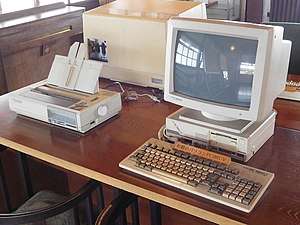 PC-9801UV11 (1988) | |
| Manufacturer | Nippon Electric (NEC) |
|---|---|
| Type | Personal computer |
| Release date | October 1982 (PC-9801) November 1992 (PC-9821) |
| Introductory price | ¥298,000 |
| Discontinued | 2003[1] |
| Units shipped | 18.3 million[2] |
| Operating system | N88-BASIC(86), CP/M-86, MS-DOS, Windows, OS/2, PC-UX |
| CPU | 8086 @ 5 MHz and higher |
| Memory | 128 kilobytes and higher |
| Sound | Yamaha YM2203, later YM2608 |
| Predecessor | PC-8800 Series |
History
Background
NEC developed mainframes since the 1950s. By 1976, the company had the 4th highest mainframe sales (10.4%) in Japan after IBM (29.6%), Fujitsu (20.1%) and Hitachi (15.8%).[5] NEC did not have a presence in the consumer market, and its subsidiary, New Nippon Electric (later NEC Home Electronics), had limited success with consumer products. However, NEC's Electronic Device Sales Division developed the microprocessor evaluation kit TK-80, which became unexpectedly popular among hobbyists. Tomio Gotō (後藤 富雄), a developer of the TK-80, observed the rise in popularity of personal computers at the 1977 West Coast Computer Faire. Computer manufacturers had not developed personal computers because they assumed microprocessors were not suitable for computing as they suffered from a lack of performance and reliability. The division decided to develop a personal computer despite criticism from the Information Processing Group, which developed mainframes, and claimed that they were making toys. The division only had a small distribution network of electronic parts stores, so they asked New Nippon Electric to sell the personal computers through their consumer distribution network.[6]
The Electronic Device Sales Division launched the PC-8001 in 1979, and it dominated 40% of the Japanese personal computer market in 1981.[7] The vice president of NEC, Atsuyoshi Ōuchi (大内 淳義), stated:
- "It is sure that we cannot deny contributions of Electronic Devices Group as a parent of the personal computer. However, if personal computers are considered computers, Information Processing Group should handle them in NEC. Also, if personal computers are considered home electronics, we cannot deny a proposal from New Nippon Electric." [8]
In April 1981, NEC decided to expand personal computer lines into three groups: New Nippon Electric, Information Processing Group, and Electronic Devices Group, with each specialising in a particular series. New Nippon Electric made 8-bit home computers (PC-6000 series), while Information Processing Group made 16-bit business personal computers and Electronic Devices Group made other personal computers such as the PC-8000, PC-8800, and PC-100 series.
Development

In the Information Processing Small Systems Division, Shunzō Hamada (浜田 俊三) directed the project and Noboru Ozawa (小澤 昇) did the product planning. The development team initially planned for the new personal computer to be a small version of the business computer line which originated from the 1973 NEAC System 100 (NEACシステム100). Kazuya Watanabe (渡邊 和也), who directed the development of the PC-8001, stated that the personal computer must have Microsoft BASIC, considered compatibility of peripheral devices with previous NEC PCs, and disclosed specifications of its expansion slot. In September 1981, Hamada requested ASCII's Kazuhiko Nishi to rewrite N88-BASIC to run on the Intel 8086 processor, and Nishi replied, saying that he wanted to talk with Bill Gates. Three months later, Nishi rejected Hamada's request because Microsoft was busy with the development of GW-BASIC, and they don't want to produce more variants of Microsoft BASIC. Nishi told him, "Microsoft is rewriting a BASIC that has the same function with more structured internal code, and it will be sold as the definitive 16-bit version named GW-BASIC. We'll provide a BASIC sooner if you choose the Japanese adoption of GW BASIC.". Hamada replied, "As I said, we want a BASIC that is compatible with the previous ones". They couldn't make an agreement.
Hamada couldn't decide which plan they should develop, a small business computer or a personal computer, because the possibilities of Watanabe's plan was uncertain. While they were visiting software companies to collect and research applications for the PC-8001 and PC-8801, Hamada and Watanabe discovered that the consumer market wanted a 16-bit machine compatible with both PCs. Hamada decided to adopt two plans for different markets. In April 1982, the small business personal computer became the NEC System 20 model 15 (NECシステム20/15), which used a proprietary 16-bit microprocessor. The machine was introduced as a new model of traditional business computers, so it was not notable.[6]
In February 1982, the software development team started reverse engineering N88-BASIC and designing N88-BASIC(86). After the team finished in March 1982, they started development on the PC-9801 (named N-10 Project). A PC-9801 prototype was completed at the end of July 1982. The code of N88-BASIC (86) was written completely from scratch, but Nishi pointed out that the bytecode matched Microsoft's. It was unclear if the copyright law could apply to the bytecode. Nishi suggested to Hamada that NEC must have purchased the same amount of Microsoft's product as it corresponded to the license fee, and N88-BASIC(86) must show copyright notification for both Microsoft and NEC. Hamada approved it. The team considered third-party developers to be very important for the market's expansion. They provided 50–100 prototypes and technical information for independent companies without a fee.[6]
In 1981, the Terminal Units Division of the Information Processing Group also launched the personal computer series N5200, which was branded as the "personal terminal". It used an Intel 8086 processor and a µPD7220 display controller. Its architecture was similar to that of the PC-98, but it mostly ran the proprietary operating system PTOS. The series was introduced as an intelligent terminal or a workstation and was distinguished within personal computer lines.[2] For this market, Fujitsu released the FACOM 9450 in 1981, and IBM Japan released the Multistation 5550 in 1983.
Release and growing
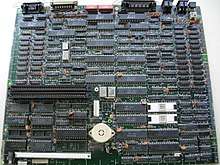
The first model, the PC-9801, launched in October 1982,[9] and employed an 8086 CPU. It ran at a clock speed of 5 MHz, with two µPD7220 display controllers (one for text, the other for video graphics), and was shipped with 128 KB of RAM that could be expanded to 640 KB. Its 8-color display had a maximum resolution of 640×400 pixels.
When the PC-9801 launched in 1982, it was initially priced at 298,000 yen (about US$1,200 in 1982 dollars). This model required an expensive 8-inch floppy disk drive or smaller capacity of 320 KB 5¼-inch floppy drive. The basic system could only display JIS X 0201 characters including numbers, English alphabets, and half-width kana, so most users added an optional kanji ROM board for using a Japanese word processor. Its successor, the PC-9801F employed an 8086-2 CPU, which could selectively run at a speed of either 5 or 8 MHz. The F2 model contained two 640 KB 5¼-inch 2DD (QD) floppy drives, a JIS level 1 kanji (2965 characters) font ROM, and was priced at 398,000 yen (about US$1,700 in 1983). It was positively received by engineers and businesses.[10]
The Electronic Devices Group launched the PC-100 in October 1983 and attempted to present a GUI and the Apple Lisa. The PC-100 did not sell well due to its time and high cost. Moreover, the marketing competed with the PC-98 of the Information Processing Group, which did not assure distributors. In December 1983, Ouchi decided that NEC would consolidate personal computer business into two divisions: NEC Home Electronics to deal with the 8-bit home computer line, and Nippon Electric's Information Processing Group to deal with the 16-bit personal computer line. The Electronic Device Group passed off their personal computer business to NEC Home Electronics.[8][11]
Fujitsu released the FM-16β in December 1984. It had an Intel 80186 CPU at 8 MHz and a 1.2 MB 5¼-inch 2HD (HD) floppy drive. The FM-16β failed because it bundled the CP/M-86, not MS-DOS, and was marketed by Fujitsu's Electronic Devices department instead of the Computers department. They modified their policies in mid-1985, but it was too late.[12] In another incident, Fujitsu bundled a business software package with the FM-11 (predecessor to FM-16β) which discouraged users from purchasing third-party software, and forced them to use it for a specific purpose, which caused Fujitsu to fail to expand their platform.[13]
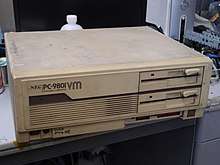
NEC introduced the PC-9801M2 that had two 5¼-inch 2HD floppy drives against the release of FM-16β. This model couldn't read a 2DD floppy disk. The PC-9801VM used NEC V30 CPU clocked at 10 MHz, and was released in July 1985. The VM2 model shipped with two 5¼-inch 2HD floppy drives and supported both 2DD and 2HD floppy disks.[14] It became the best-selling computer in Japan, with annual sales of 210,000 units.[15]
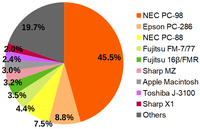
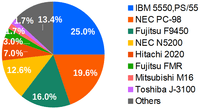
NEC permitted software companies to bundle a subset of the MS-DOS 2.11 without a license fee between 1983 and 1987. ASCII and Microsoft allowed it to enter the market and compete with the CP/M-86.[17] NEC also let users buy a self-contained application package.[18] It dominated half of the Japanese personal computer market at the end of 1983. As of March 1984, 700 software packages were available for PC-98. In 1987, NEC announced one million PC-98s were shipped, and about 3,000 software packages were available. Masayoshi Son (a founder of SoftBank) recalled in 1985 that:[19]
The gap in share of the personal computer market is growing. Even though the start was not limited to NEC only, why did this gap cause? It can be said that NEC has taken a positive attitude towards disclosing hardware and operating systems since the early period, and free for third parties to develop software and peripherals. While the competitors adopted the same Microsoft's BASIC, they didn't disclose them. This difference in attitude is reflected in today's share.
NEC took care to maintain compatibility and inheritance. The PC-9801VM could select a clock frequency from 8 and 10 MHz and also offered an optional 8086 card because the V30 had different instruction cycles.[14] The V30 had unique instructions which were not implemented in Intel x86 processors. Some PC-98 applications used them, so the PC-9801VX (1986) was designed to run Intel 80286 and V30 selectively. The PC-9801RA (1988) had an Intel 80386 and a V30. The PC-9801DA (1990) did not have this, but its clock speed was configurable.[2]
NEC focused heavily on financing advertisements and exhibitions, from ¥1,000,000,000 in the 1970s, to over ¥25,000,000,000 in 1985.[20]
While NEC did not market these specific machines in the West, it sold the NEC APC III, which had similar hardware as early PC-98 models.[21] However, NEC began selling an IBM compatible PC (APC IV) outside Japan in 1986.[22]
Race with laptops and PC-98 clones

Toshiba had developed laptop computers since the autumn of 1983, while their desktops were a failure in the Japan PC market. In October 1986, they introduced the J-3100 which allowed the T3100 to handle Japanese text. NEC did not expect it to become the first successful laptop computer in Japan. In the same month, NEC introduced the PC-98LT laptop computer.[23] This model had poor compatibility with the PC-9801 and could not gain a significant profit. NEC understood, despite difficulties, that the PC-98 needed a new custom chipset to make the motherboard smaller.[24]
In March 1987, Epson announced the first PC-98 clone desktop computer and named it the PC-286 series. NEC investigated and sued Epson on the claim that its BIOS infringed their copyright. Epson cancelled their PC-286 model 1-4 and released the PC-286 model 0 whose BIOS was made by another team under a clean room design: it did not have a built-in BASIC interpreter. NEC countered that the PC-286 model 0 lacked compatibility with the PC-98. Although it seemed NEC would not be able to win the lawsuit, Epson settled with NEC in November 1987 after considering the damage that would be done to its reputation.[22]

The PC-286 model 0 employed an Intel 80286 processor operating at 10 MHz, which was 20% faster than NEC's mainstream model PC-9801VX using the same CPU at 8 MHz. In June 1987, NEC released a 10 MHz version of PC-9801VX (VX01, VX21 and VX41 models). They added a BIOS signature check to their operating systems (Disk versions of BASIC and MS-DOS), to prevent non-NEC machines from booting up; it was commonly called an "EPSON check". In September 1987, Epson introduced the PC-286V and the PC-286U, and also released the BASIC Support ROM to add a BASIC interpreter. Epson also bundled the Software Installation Program which was a patch kit to remove the EPSON check. Both machines were received well due to reasonable prices and better compatibility.[22] In 1988, Epson made annual sales of 200,000 units and successfully established PC-98 clones in the Japan PC market.[25]
In October 1987, Epson released the PC-286L which was a PC-98 compatible laptop before NEC started development.[26] In March 1988, NEC released the PC-9801LV which was a 100% PC-98 compatible laptop PC. It was accomplished by three custom VLSI chips.[27] These chipsets were also used in other desktops such as the PC-9801UV11 and the PC-9801RA.[28]
In July 1989, Toshiba released the J-3100SS branded as DynaBook, a true laptop computer which was light and battery operable.[29] It made annual sales of 170,000 units. Four months later, NEC released the PC-9801N and branded it as "98NOTE".[30] The DynaBook started off well but the 98NOTE exceeded it in 1990.[31]
Microsoft and other PC manufacturers developed the AX specification in 1987. It allowed IBM PC clones to handle Japanese text by using special video chips, the Japanese keyboard, and software written for it. However, the AX could not break into the Japanese PC market due to its higher cost and less compatible software.
As a PC game platform

In the early 1980s, home users chose 8-bit machines rather than 16-bit machines because 16-bit systems were expensive and exclusively for business. By the mid-1980s, the Japanese home computer market was dominated by NEC PC-88, Fujitsu FM-7 and Sharp X1. In this era, a simulation game was the most popular genre for PC-98, which took advantage of higher clock speed and larger memory reserves. Daisenryaku and Romance of the Three Kingdoms were particularly popular and they established PC-98 as a PC game platform.[13]
Towards the end of the 1980s, the Japanese PC game platform slowly shifted from PC-88 to PC-98, as X68000 and FM TOWNS also had a niche market. In the 1990s, many computer role-playing games were developed for PC-98 or imported from other platforms, such as Brandish, Dungeon Master and the Alone in the Dark series. The higher display resolution and higher storage capacity allowed better graphics, but drawing animations on the PC-98 was hard because it took a long time to draw the screen. As a result of this limitation, adult dating sims and visual novels appeared as a revival of 1980's adventure games and gained popularity, such as Dōkyūsei and YU-NO. After the PC-98 declined, many Japanese PC game developers shifted the game platform to video game consoles, except for eroge distributed by computer stores.[33]
Price war with DOS/V PCs
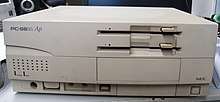
In the 1980s and early 1990s, NEC dominated the Japanese domestic PC market with more than 60% of the PCs sold as PC-9801 or PC-8801.[34] In 1990, IBM Japan introduced the DOS/V operating system which enabled displaying Japanese text on standard IBM PC/AT VGA adapters. Other Japanese PC manufacturers joined the PC Open Architecture Developer Group (OADG) organized by IBM Japan and Microsoft. In October 1992, Compaq released a DOS/V computer priced at ¥128,000 compared to the lowest priced PC-98 at ¥248,000, causing a price war in the Japanese PC market.[35] In 1993, Toshiba introduced DOS/V computers, Epson founded Epson Direct Corporation to sell DOS/V computers, and Fujitsu started selling DOS/V computers branded as FMV.

In November 1992, NEC introduced a mid-range Windows PC, the PC-9821 which contained Intel 386SX processor, a CD-ROM drive, 16-bit PCM audio playback, MS-DOS 5.0A and Windows 3.0A. In January 1993, PC-98 desktops were expanded into three lines, a high performance Windows machine named "98MATE", a low-priced MS-DOS machine named "98FELLOW", and an all-in-one desktop named "98MULTi". PC-98s were still popular among Japanese users because they had many Japanese applications.[36]
NEC managed to adopt industrial standards and reduce costs. From 1993 to 1995, the PC-98 adopted 72-pin SIMMs, 3.5-inch 1.44 MB floppy format, IDE storage drives, 640×480 pixels DOS screen mode, 2D GUI acceleration GPUs, Windows Sound System, PCI, and PCMCIA card slots.[37] NEC had outsourced manufacturing of motherboards to Taiwanese companies such as ECS and GVC (acquired by Lite-On).[38]
Decline
Aside from other Japanese domestic platforms which had disappeared, Windows 95 overturned the dominance of the PC-98. The difference in the architecture was not only ineffective for platform-independent environments but also increasing development resources to adopt them.[39] In 1997, NEC introduced the PC98-NX series as a main personal computer line that conformed to the PC System Design Guide and were IBM PC compatible.[37] The PC-9801's last successor was the Celeron-based PC-9821Ra43 (with a clock frequency of 433 MHz, using a 440FX chipset-based motherboard design from 1998), which appeared in 2000. NEC announced that the PC-98 would be discontinued in 2003. 18.3 million of PC-98s shipped by the end of shipments in March 2004.[2] The last version of Windows to support PC-98 was Windows 2000.
NEC kept much of its hardware and platform proprietary or under license, so while it had a virtual monopoly in the Japanese market, later IBM PC clones with DOS/V and Windows from companies such as Hitachi and Panasonic that did not require such license fees (like Epson's 98 clones) flooded the market and displaced NEC.
Hardware
The PC-98 is different from the IBM PC in many ways; for instance, it uses its own 16-bit C-bus (Cバス) instead of the ISA bus; BIOS, I/O port addressing, memory management, and graphics output are also different. However, localized MS-DOS, Unix, OS/2, or Windows will still run on PC-9801s.
Expansion bus
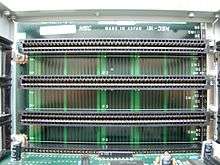
All PC-98 desktop models use a 100-pin expansion slot. It has 16 data and 24 address lines. The bus frequency is fixed at 5, 8 or 10 MHz. PC-H98 and PC-9821A Series use a proprietary 32-bit Local Bus slot and existing 16-bit slot. The 16-bit expansion bus was also called C-bus (Compatible Bus). The PC-9821Xf introduced in 1994 shipped with C-bus slots and PCI slots on the motherboard, replacing Local Bus.
Memory
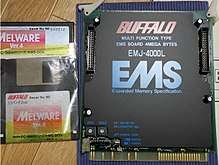
Many PC-9801 models could increase system memory by installing expansion boards, daughterboards, or proprietary SIMMs. They were limited to 14.6 MB, due to 24-bit address pins and reserve space. EMS memory boards for C-bus were also available. The PC-9821Af introduced in 1993 shipped with standard 72-pin SIMMs, broke 14.6 MB barrier and supported memory up to 79.6 MB. Later desktop models shipped with standard SIMM or DIMM memory.
The PC-98XA (1985) and its successors, called high-resolution machine or simply hi-reso machine, were capable of 768 KB base memory, but I/O port and memory addressing was quite different from normal PC-98.
Storage
Early PC-9801 models supported 1232 KB 8-inch floppy drives and/or 640 KB 5¼-inch floppy drives. Each used different IRQ lines and I/O ports. Later models supported both interfaces. 5¼-inch and 3½-inch HD floppy disks used the same logical format and data rate with 1232 KB 8-inch floppy disks. They became a non-standard format while formats brought by IBM PC/AT and PS/2 became the industry standard.
The PC-98 supports up to four floppy drives. If the system is booted from a floppy drive, MS-DOS assigns letters to all of the floppy drives before considering hard drives; it does the opposite if it is booted from a hard drive. If the OS was installed on the hard drive, MS-DOS would assign the hard drive as drive "A:" and the floppy as drive "B:"; this would cause incompatibility among Windows PC applications, although it can be resolved with the SETUP command in Windows 95 by turning on the "/AT" switch to assign the Windows system drive to the standard "C:" drive.
The PC-98 used several different interfaces of hard drives. Early models used Shugart Associates System Interface (SASI) or ST506, and later models used SCSI or IDE drives.
Graphics
_color_text_with_graphics.png)
A standard PC-98 has two µPD7220 display controllers (a master and a slave) with 12 KB main memory and 256 KB of video RAM respectively. The master display controller handles font ROM, displaying JIS X 0201 (7x13 pixels) and JIS X 0208 (15x16 pixels) characters. Each character had a variety of display options, including bits for secret, blinking, reverse, underline and three intensity bits (grayscale or RGB). The other display controller is set to slave mode and connected to 256 KB of planar video memory, allowing it to display 640 x 400 pixel graphics with 16 colors out of a palette of 4096. The video RAM is divided into pages (2 pages x 4 planes x 32 KB in 640x400 16 colour mode), and the programmer can control which page is written to and which page is output.
The high-resolution machines (PC-98XA, XL, and PC-H98) offered 1120x750 display mode, and aimed for tasks such as CAD and word processing.
The PC-9801U (optional) and VM introduced a custom chipset GRCG (GRaphic CharGer) to access several planar memory in parallel. The PC-9801VX introduced a blitter chip called EGC (Enhanced Graphic Charger).[40] It had raster operations and bit shifting.
In 1993, NEC introduced a 2D Windows accelerator card for PC-98 called the Window Accelerator Board and employed S3's 86C928. Video cards for C-bus, local bus and PCI were also available from other manufacturers.[41] DirectX 7.0a was the last official supported version for PC-98.[42]
Sound
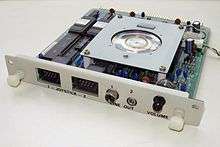
The first generation of PC-9801s (the E, F, and M models) only had an internal buzzer. PC-9801U2 and later models could change the sound frequency by controlling the programmable interval timer, like the PC speaker. The PC-8801mkIISR home computer, introduced in 1985, had a Yamaha YM2203 sound chip, an Atari joystick port, and BASIC sound commands. The optional PC-9801-26 sound card was based around these features, although in some PC-9801 models it is integrated with the motherboard. It was replaced by the PC-9801-26K to support the 80286 CPU. This became the most common sound card for playing in-game music on the PC-98.[43]
It was succeeded by the PC-9801-73 (1991) and PC-9801-86 (1993) sound card, which employed the YM2608 and added support for 16-bit stereo sampling. Due to lack of DMA support and poor sound drivers, it often had issues in Windows and created popping and clicking sounds.[44] The PC-9801-118 sound card and later PC-9821 models use the Crystal Semiconductor's Windows Sound System audio codec to resolve this, but the newer sound chip was not compatible with the older conventional sound cards.[45]
Roland released the MPU-401 MIDI interface card for PC-98 computers. Creative Labs released a C-bus card for Sound Blaster 16.
Keyboard
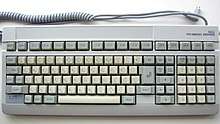
The first PC-9801 model had the same keyboard layout as the PC-8801's except it added conversion key XFER and 5 function keys. Later models had some minor changes: NFER, 15 function keys, LED status indicators, and replacing CAPS and Kana (カナ) alternate action switches.[46]
Epson clones
Seiko Epson manufactured PC-9801 clones between 1987 and 1995, as well as compatible peripherals.[47]
AST Research Japan released the DualStation 386 SX/16 in 1990 which had both PC-9801 and IBM PC compatibilities,[48] but it failed because of poor marketing.[49]
Software
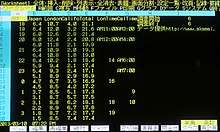
The PC-98 was primarily used for business and industry in Japan from 1980s to mid-1990s. As of September 1992, out of 16,000 PC-98 software applications, 60% of them were corporate business software applications (including CAD), 10% of them were operating systems and development tools, 10% of them were educational software applications, with the rest being a mix of graphic design, networking, word processing, and games.[50] The Nikkei Personal Computing journal published in 1993 reported that most home users purchased PCs to complete office work at home. The publisher sent a questionnaire to 2000 readers, and out of 1227 readers who answered, 82% of users used it for word processing, 72% for spreadsheets, 47% as a database, and 43% for games.[36]
Ichitaro, a Japanese word processor for the PC-98 and considered one of its killer applications, was released in 1985[51] and ported to other machines in 1987. A Japanese version of Lotus 1-2-3 was also ported to PC-98 first in 1986.[18] 1 million copies of all Ichitaro versions and 500,000 copies of Lotus 1-2-3 were shipped by 1991.[52][53]
PC-98 software generally ran from program and data disks (Disk 0 & 1 or A & B). For example, Ichitaro's system disk contained a runtime version of MS-DOS, main programs, an input method editor (ATOK), and its dictionary file. It used the entire space of a 1.2 MB floppy disk.[51] In 1980s, most machines only had two floppy drives because HDDs were an expensive additional feature for PCs.
NEC provided a variety of operating systems including the CP/M-86, Concurrent CP/M, MS-DOS, PC-UX, OS/2, and Windows (discontinued after Windows 2000).[50][54] Localized versions of NetWare and FreeBSD were also available.
The PC-98 had many game titles designed for it, many of which made creative use of the system's limitations (as it was originally designed as a business machine) to great commercial success. Despite having hardware specifications inferior to the FM Towns and X68000, the massive install base and steady flow of game titles (in particular "dōjin" style dating sims and RPGs, as well as early games of Policenauts, YU-NO: A Girl Who Chants Love at the Bound of this World, Koutetsu no Kishi, Mayonaka no Tantei Nightwalker, MechWarrior, Rusty, Hiōden: Mamono-tachi tono Chikai, Shūjin e no Pert-em-Hru, Corpse Party, Slayers, J.B. Harold Murder Club, and Touhou Project) kept it as the favored platform for PC game developers in Japan until the rise of the DOS/V clones.
Models
Partial list of PC-98 models sold in the Japanese market (no 1992-2000 models, no notebook models, etc.).
| Model | CPU | Year | Features | Other |
|---|---|---|---|---|
| PC-9801 | 8086 5 MHz | 1982 | RAM 128 KB, 6 slot C-bus, larger DIN connector for keyboard | 640×400 8 colors, 2 externals floppy drive 8" (optional) 298,000yen |
| PC-9801E | 8086-2 5/8 MHz | 1983 | Essentially the same as PC-9801, integrated logical circuits into several ASICs, mini DIN keyboard connector | 2 externals floppy drive 8" (optional) |
| PC-9801F | 8086-2 5/8 MHz | 1983 | With display font of JIS level 1 kanji characters, F1 and F2 with 128KB of RAM, F3 256 KB of RAM and hard-disk 10 Mb | Internal floppy drive, 5" 2DD (640KB/720KB) |
| PC-9801M | 8086-2 5/8 MHz[55] | 1984 | With bus mouse interface card | M1: 2 internal floppy drive, 5" 2HD (1.2MB); M2: 1 internal floppy and HD 20Mb |
| PC-9801U | NEC V30 8 MHz | 1985 | Has display font of JIS level 1 and level 2 kanji characters | 2 floppy-disk 3.5" 2DD |
| PC-9801VF | NEC V30 8 MHz | 1985 | RAM 256 KB, GRCG (Graphic Charger) | Double 5" floppy-disk 2DD 640×400 resolution with 8 colors (16 colors optional) chosen from among the 4096 available |
| PC-9801VM | NEC V30 10 MHz | 1985 | RAM 384 KB, GRCG | Double 5" floppy-disk 2HD/2DD 640×400 resolution with 8 colors (16 colors optional) chosen from among the 4096 available |
| PC-9801UV | NEC V30 10/8 MHz | 1986 | Onboard PC-9801-26 sound hardware, GRCG, UV2 (1986) with 384 KB of RAM, UV21 (1987) 640 KB of RAM, UV11 (1988) reduced 45% size of UV21's and 73% lower power consumption[27] | 2 floppy-disk 3.5" 2HD/2DD |
| PC-9801VX | 80286 8-10 MHz | 1986 | RAM 640 KB, EGC (Enhanced Graphic Charger), VCCI compliance | 640×400 resolution with 16 colors chosen from among 4096, VX4/WN bundled MS-DOS 3.1 and Windows 1.0[56] |
| PC-9801UX | 80286 10 MHz | 1987 | Onboard 26K sound, EGC | 2 floppy-disk 3.5" 2HD/2DD |
| PC-9801RA | 80386DX 16-20 MHz | 1988 | Reduced 12% size of 9801VX's,[28] covered floppy drives to dampen sound | 2 floppy-disk 5" 2HD/2DD |
| PC-9801RS | 80386SX 16 MHz | 1989 | 2 floppy-disk 5" 2HD/2DD | |
| PC-9801RX | 80286 12 MHz | 1988 | 2 floppy-disk 5" 2HD/2DD | |
| PC-9801ES | 80386SX 16 MHz | 1989 | ES2 no HD, ES5 HD 40MByte | 2 floppy-disk 3.5" 2HD/2DD |
| PC-9801EX | 80286 12 MHz | 1989 | Onboard 26K sound | 2 floppy-disk 3.5" 2HD/2DD |
| PC-9801DA,DA/U | 80386DX 20 MHz | 1990 | Onboard 26K sound, software menus replaced DIP switches | /U means 3.5" floppy No /U means 5" floppy |
| PC-9801DS,DS/U | 80386SX 16 MHz | 1990 | Onboard 26K sound | /U means 3.5" floppy No /U means 5" floppy |
| PC-9801DX,DX/U | 80286 12 MHz | 1991 | Onboard 26K sound | /U means 3.5" floppy No /U means 5" floppy |
| PC-9801FA,FA/U | 80486SX 16 MHz | 1992 | Onboard 26K sound | F means "File slot", proprietary memory expansion slot |
| PC-9801FS,FS/U | 80386DX 16 MHz | 1992 | Onboard 26K sound | |
| PC-9801FX,FX/U | 80386SX 16 MHz | 1992 | Onboard 26K sound | |
| PC-9821 | Intel 80386SX | 1992 | 3.6 MB of RAM, CD-ROM drive, onboard 86 sound hardware | Hard disk 40 MByte, 640x480 resolution with 256 colors, Windows 3.0A pre-installed |
| PC-9821Ap | 80486DX2 66 MHz | 1993 | 3.6 MB of RAM, onboard 86 sound, support 3.5" 1.44 MB floppy disk | Hard disk none or 120-510 MB with IDE, 640×480 resolution with 256 colors, MS-DOS 5.0A-H pre-installed |
| PC-9801BA | 80486DX 40 MHz | 1993 | 1.6-3.6 MB of RAM, 86 sound card (optional), support 3.5" 1.44 MB floppy disk | Hard disk none or 80 MB with IDE, MS-DOS 5.0A-H pre-installed |
| PC-9821Ce | 80486SX 25 MHz | 1993 | Essentially the same as PC-9821 | Windows 3.1 pre-installed |
| PC-9821Af | Pentium 60 MHz | 1993 | 7.6 MB of RAM, broke 14.6 MB memory barrier,[50] JEDEC 72-pin SIMM, S3 928 2D accelerator | Hard disk 510 MB, Windows 3.1 pre-installed |
| PC-9821Cx | 80486SX 33 MHz | 1994 | MS-DOS 6.2/Windows 3.1 pre-installed | |
| PC-9821Cf | Pentium 60 MHz | 1994 | Built-in TV tuner, MS-DOS 5.0A-H/Windows 3.1 pre-installed | |
| PC-9821Xa | Pentium 90 MHz | 1994 | 7.6 MB of RAM, 1x-4x CD-ROM, Matrox MGA-II, 2x PCI slots, Plug and Play C-bus, WSS audio | Hard disk 270-1000 MB |
| PC-9821Cx2 | Pentium 75 MHz | 1995 | CD-ROM 4x drive | Hard disk 850 MB, built-in TV tuner, MS-DOS 6.2/Windows 3.1 pre-installed |
| PC-9821Cx3 (98Multi Canbe) | Pentium 100 MHz | 1995 | Include Yamaha DB60XG Daughterboard | Windows 95 pre-installed |
| PC-9821 Valuestar V Series V166-V233 | Pentium MMX 166-233 MHz | 1997 | 8x-20x CD-ROM, 2x CD-R, or DVD-ROM drive, 32 MB of RAM, Matrox Mystique 3D accelerator, Harddisk 3-6 GB, 2x USB ports | Windows 95 OSR2.1 pre-installed |
| PC-9821 Cereb (C166-C233) | Pentium MMX 166-233 MHz | 1997 | 28 inch (in C200 Model) or optional 32 inch BS Hi-Vision TV Monitor, Harddisk 3-4GB, VideoLogic Apocalypse 3D 3D accelerator (in C166 Model), DVD and MPEG-2 Decoder (in C200/V and C233/V Model), built-in TV tuner, 13x CD-ROM or DVD-ROM drive (read CD-ROM at 6x in C200/V Model and 8x in C233/V Model), 32 MB of RAM, 2x USB ports (in C233 Model) | Windows 95 OSR2.1 pre-installed |
| PC-9821Ra43 | Celeron 433 MHz | 2000 | 24x CD-ROM drive, 32 MB of RAM, Harddisk 8GB, | Last computer of series |
Timeline of PC-9801 models
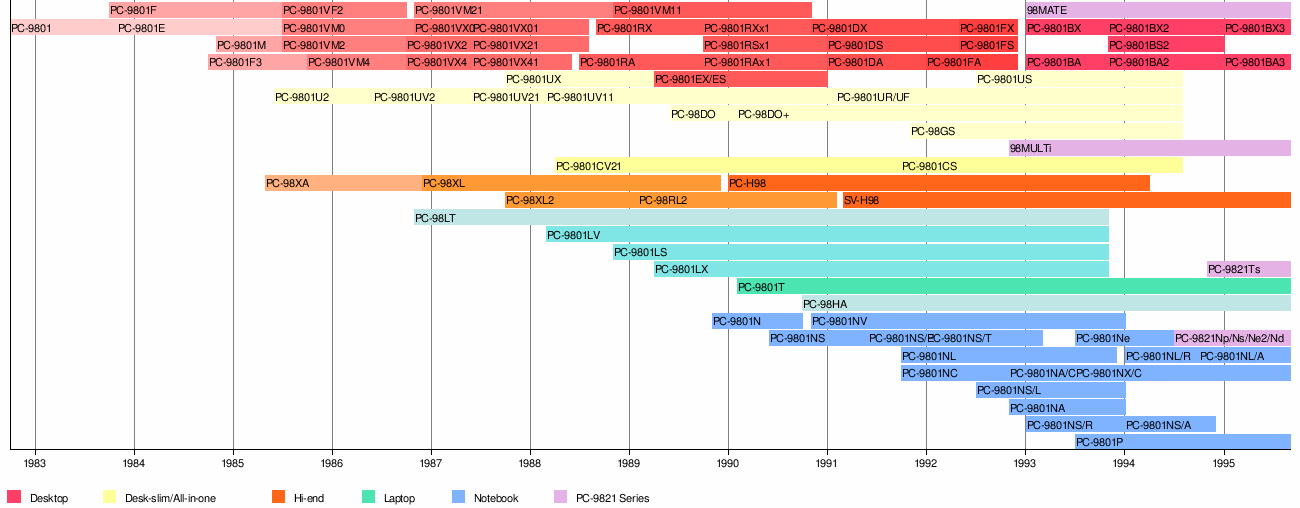
Reception
Marketing
A journalist explained in 1988 how NEC established the nation of Japanese personal computers:[12]
- NEC responded quickly to the new demand for business personal computers.
- NEC succeeded in attracting many third-party suppliers and dominated software production and distribution.
- NEC adopted Microsoft's MS-DOS as an operating system for the PC-98.
Western computers lacked Japanese support due to its display resolution and speed, so they could not get into the Japanese PC market until the DOS/V and faster computers came out; for example, IBM Japan sold the IBM 5550 instead of the IBM PC. Akihiko Hyodo, a programmer who developed the text editor VZ Editor, said two advantage that the PC-98 had were its kanji character memory and non-interlaced monitor. Both provided users with a more comfortable Japanese environment.[57] A senior vice president of Otsuka Shokai (a computer distributor for enterprises) recalled that "early users such as Kao already had office automation with the PC-8000, but it lacked speed and kanji support. Then, the PC-9800 was released, and it was perfect, so distributors and users immediately switched to it.".[58]
Shunzo Hamada of NEC thought the biggest reason for the success of PC-98 was that NEC could get software companies to cooperate. He said, "Third-party suppliers of Japanese PCs had already grown up to a certain extent. However, it was not because they were organized. They were born by themselves, and hardware manufacturers didn't touch them. When we developed the PC-9800 series, we changed our method to make a conscious effort to grow them up".[59]
Ichiran Kou, a computer consultant, pointed out that IBM influenced NEC's strategy. Since 1982, NEC had four personal computer lines, and they covered a wide price range, similar to IBM's mainframe business. However, NEC's computers had poor backward compatibility and as such was criticized by users and software developers. After reforming personal computer lines in 1983, NEC began expanding the PC-9801 series and its number of models exceeded its competitors.[60]
NEC encouraged third-party developers as IBM did for the IBM PC. The basic hardware of PC-98 was also similar to the IBM PC, though it was not IBM compatible. Kou guessed that NEC avoided releasing an IBM compatible PC because the company was proud of developing an original mainframe.[60]
Yasuhiro Uchida, a literature professor, wrote an essay titled "Users chose the most playable PC". He felt the PC-98 was an "ordinary" 16-bit personal computer, but it had plenty of games because it did not deny the playability. He theorized that Fujitsu did not consider the 16-bit personal computer as a game platform, and considered IBM JX handling games to be of minor importance, which made personal computers less attractive. He concluded that the actual value of personal computers must be found by not sellers but consumers.[13]
Legacy
A writer of the ASCII magazine wrote that the Japanese input method and the Japanese video game industry were significantly developed in the PC-98 era. Because the PC-98 had a kanji character ROM, Japanese applications were developed for it, which influenced Japanese input methods being developed for them; the two built off of each other. Software companies that developed games for the PC-98 immediately expanded the video game business on the Famicom platform. He believed most programmers learned computer programming on the PC-98 at that time.[57]
Criticism
In the late 1980s, competitors criticized NEC monopolizing the market. Takayoshi Shina, a founder of Sord, said, "The Japanese PC market is suffocating because of one company's dominance. There is no freedom. This is why its prices are 3-4 times as expensive as America's. To fulfil the same international price as America's, we really need the era of clone computers.". A software company also complained that "although there are few excellent engineers in Japan, the more incompatible machines appear, the more development resources are divided.".[22]
Contrary to the IBM PC and the Apple II, every Japanese personal computer had a short lifespan; NEC released a new model of the PC-98 every year. When the PC-9801VX01/21/41 models brought a new BASIC interpreter which supported the Enhanced Graphic Charger (EGC) chipset, most commercial software did not use it as they were written in C. Many developers did not follow it because they wanted to make their software less dependent on the specific platform. A software developer said, "Using the special one (EGC) goes against the trend. I don't want to use it if new machines come out so frequently.".[61]
See also
- PC game
- PC-8800 Series
- X68000
- TurboGrafx-16
- Commodore 64
- FM-7
- FM Towns
- MSX
References
- "PC-9800シリーズ受注終了のお知らせ" [PC-9800 Series Discontinuation Notification] (in Japanese). NEC. Retrieved June 7, 2016.
- "PC-9800シリーズの生みの親が語る「日本標準機」の誕生秘話 : NEC 小澤昇インタビュー". 蘇るPC-9801伝説 永久保存版 第1弾 (in Japanese). ASCII. 2004. pp. 114–120. ISBN 4-7561-4419-5.
- "用語解説辞典【キューハチ】". NTT PC Communications. Retrieved 2019-03-24.
- "Computing Japan". Computing Japan. LINC Japan. 54-59: 18. 1999. Retrieved 6 February 2012.
...its venerable PC 9800 series, which has sold more than 18 million units over the years, and is the reason why NEC has been the number one PC vendor in Japan for as long as anyone can remember.
- 高橋, 清美 (2018). "コンピュータ企業における国際化と国際競争力(1950年代~1990年代まで) -IBMと富士通のメインフレーム事業を中心に-" [Internationalization and International Competitiveness in Computer Companies (the 1950s to the 1990s) -Focusing on the Mainframe Business of IBM and Fujitsu-]. Meiji Repository. Meiji University. p. 91. Retrieved 2019-06-23.
- 富田, 倫生 (1995). パソコン創世記 (in Japanese). ボイジャー. Retrieved 2019-03-11 – via Aozora Bunko.
- パソコン大図鑑 最新・人気パソコン目的別全カタログ (in Japanese). Kodansha. 1981. pp. 30–31. ISBN 4-06-141673-1.
- 日本電気社史編纂室 (2001-12-25). 日本電気株式会社百年史 (in Japanese). NEC. p. 654. OCLC 676485242.
- John Szczepaniak. "Retro Japanese Computers: Gaming's Final Frontier". Hardcore Gaming 101. p. 2. Retrieved 2011-03-16. Reprinted from "Retro Japanese Computers: Gaming's Final Frontier", Retro Gamer (67), 2009
- 神永, 裕人 (1988). "NECのハード開発戦略 ユーザーをとらえた「互換性と継承性の追求」優先の製品開発". In コンピュータ・ニュース社 (ed.). 100万人の謎を解く ザ・PCの系譜 (in Japanese). コンピュータ・ニュース社. pp. 94–105. ISBN 4-8061-0316-0.
- 田中, 繁廣 (1988-02-17). "ドキュメント・NECのPC戦略―市場制覇への道を切り拓いた戦士達 その決断と挑戦の歴史". 100万人の謎を解く ザ・PCの系譜 (in Japanese). コンピュータ・ニュース社. pp. 76–89. ISBN 4-8061-0316-0.
- 小林, 紀興 (1988). "NECがパソコン王国になった理由". In コンピュータ・ニュース社 (ed.). 100万人の謎を解く ザ・PCの系譜 (in Japanese). コンピュータ・ニュース社. pp. 58–59. ISBN 4-8061-0316-0.
- 内田, 保廣 (1988). "一番"遊戯性"の高いPCをユーザーは選択した". In コンピュータ・ニュース社 (ed.). 100万人の謎を解く ザ・PCの系譜 (in Japanese). コンピュータ・ニュース社. pp. 128–129. ISBN 4-8061-0316-0.
- "PC-9801VM/VF徹底研究". ASCII. ASCII. 9 (9): 249–256. 1985. ISSN 0386-5428.
- "日電ビジネス用パソコン好調―単一モデル1年で21万台出荷。". Nikkei Sangyo Shimbun (in Japanese). Nihon Keizai Shimbun. 1986-08-18. p. 7.
- 松岡, 資明; 中川, 貴雄; 礒田, 温之; 西村, 裕 (1989-04-10). "調査:パソコン・シェア 企業はPS/55、家庭はPC-9800". 日経パソコン (in Japanese). Nikkei Business Publications: 280–281. ISSN 0287-9506.
- 服部, 雅幸 (1991-01-21). "トピック・レポート ソフト:機能不足が表面化,老兵「MS-DOS2.11」". 日経パソコン (in Japanese). Nikkei Business Publications. 136: 178–182. ISSN 0287-9506.
- Edward Warner (1986-09-08). "Lotus Perseveres to Unveil Japanese Version of 1-2-3". InfoWorld. p. 9. Retrieved 2016-05-02.
- 小林, 紀興 (1997). インテル・マイクロソフト ウィンテル神話の嘘 (in Japanese). Kobunsha. p. 119. ISBN 4-334-00599-3.
- 佐野, 真一 (1988-02-17). "NECのイメージアップ作戦を指揮した3人の男". 100万人の謎を解く ザ・PCの系譜 (in Japanese). コンピュータ・ニュース社. pp. 90–91. ISBN 4-8061-0316-0.
- "Old-Computers.com". Archived from the original on April 23, 2011. Retrieved 5 May 2011.
- 松尾, 博志 (1988). "パソコン産業"互換機元年" 真の「ユーザー利益」は、「企業利益」追求の互換機ビジネスから". In コンピュータ・ニュース社 (ed.). 100万人の謎を解く ザ・PCの系譜 (in Japanese). コンピュータ・ニュース社. pp. 130–137. ISBN 4-8061-0316-0.
- "【日本電気】 PC-98LT". コンピュータ博物館. Information Processing Society of Japan. Retrieved 2019-04-22.
- 関口, 和一 (2000-03-06). ""挑戦者たち"". パソコン革命の旗手たち. Nihon Keizai Shimbun. pp. 203–236. ISBN 4-532-16331-5.
- 大河原, 克行 (2007-09-28). "業界タイムマシン19XX--Trip11:セイコーエプソン vs. NEC PC-98互換機騒動". ZDNet Japan. Retrieved 2019-03-30.
- "【セイコーエプソン】 PC-286L". コンピュータ博物館. Information Processing Society of Japan. Retrieved 2019-03-21.
- "ASCII EXPRESS : 日本電気がPC-9800シリーズの新機種を発表、PC-9801UV21互換のラップトップを含む3機種。". ASCII (in Japanese). ASCII. 12 (4). 1988. ISSN 0386-5428.
- "PRODUCTS SHOWCASE : 低価格386マシン&ソフトも一新 PC-9801RAシリーズ". ASCII (in Japanese). ASCII. 12 (9): 189–195. 1988. ISSN 0386-5428.
- "【東芝】 DynaBook J-3100SS". コンピュータ博物館. Information Processing Society of Japan. Retrieved 2019-03-21.
- "【日本電気】 PC-9801N(愛称98NOTE)". コンピュータ博物館. Information Processing Society of Japan. Retrieved 2019-03-21.
- "特集 : 追う98、追われる98". 日経パソコン (in Japanese). Nikkei Business Publications: 130–145. 1993-03-15. ISSN 0287-9506.
- Japan Electronic Industries Development Association (1995). パソコン白書94-95 (in Japanese). コンピュータ・エージ社. p. 31. ISBN 4875661479.
- 阿部, 広樹 (2004). "PC-9801 魂の名作ゲームの旅". 蘇るPC-9801伝説 永久保存版 第1弾 (in Japanese). ASCII. pp. 121–125. ISBN 4-7561-4419-5.
- Alsop, Stewart (1991-07-29). "U.S. computer companiew: Get off your high horse". InfoWorld. 13 (30): 4. Retrieved 2019-08-23 – via Google Books.
- 鎌田, 剛 (2019-01-10). "激動の平成デジタルガジェット史 第2回:平成4~6年(1992~1994年)". 価格.comマガジン (in Japanese). Kakaku.com. Retrieved 2019-03-18.
- "パソコンユーザー実態調査 第1部 個人編 他機種を引き離すPC-98". 日経パソコン (in Japanese). Nikkei Business Publications: 132–137. 1993-06-21. ISSN 0287-9506.
- 小高, 輝真 (1997-09-26). "小高輝真の「いまどきの98」 : PC-9800からPC98-NXへ". Impress PC Watch (in Japanese). Retrieved 2019-03-16.
- 木瀬, 裕次 (1995-03-13). "第2特集 : 浸透する台湾パソコン(前編)". 日経パソコン (in Japanese). Nikkei Business Publications: 182–187. ISSN 0287-9506.
- 本間, 健司 (1996-02-12). "NECはWin 95で98らしさをだせたか―ほとんどなくなった98とDOS/Vの違い". 日経パソコン (in Japanese). Nikkei Business Publications: 160–164. ISSN 0287-9506.
- "新機種緊急レポート : PC-9801VX". ASCII. ASCII. 10 (12): 130–133. 1986. ISSN 0386-5428.
- "PCIバス用 S3社Savage2000搭載 DVI出力対応グラフィックアクセラレータ GA-S2K32/PCI". IO-DATA. Retrieved 2019-04-24.
- "DirectX Home Page - ダウンロード". Microsoft. 2002-04-22. Archived from the original on 2002-08-03. Retrieved 2019-04-24.
- "PC-9801めくるめく音源ボードの世界" [The world of sound boards for PC-9801]. 蘇るPC-9801伝説 永久保存版 第2弾 [Coming back the legend of PC-9801 Volume 2] (in Japanese). ASCII. 2007. ISBN 978-4-7561-4883-4.
- 靖間, 誠. "PC-9801-118 / NEC". Retrieved 2018-05-24.
- "質問 : PC-9801-118を使ってMS-DOS上でFM音源を鳴らしたい。" [Question: I want to play sound with FM synthesizer on MS-DOS using PC-9801-118.]. NEC PC Information Center ROBO (in Japanese). NEC. Archived from the original on 1997-06-10. Retrieved 2018-05-24.
- yagura (2002-10-18). "PC-98 キーボード". nkmm the Metal. Retrieved 2018-01-08.
- "EPSON PC`s DATABASE TOP PAGE" (in Japanese). Retrieved June 10, 2016.
- Li Nakamura, Roxanna (1990-04-16). "AST Announces Dual Operating System PC For Japanese Market". InfoWorld. 12 (15): 20. Retrieved 2019-08-23 – via Google Books.
- "なぜ広がらない98互換機ビジネス「幻の98互換機」があった". 日経パソコン (in Japanese). Nikkei Business Publications: 110–115. 1992-02-03. ISSN 0287-9506.
- "特別企画 : 98とともに歩く、これからの10年". Oh! PC (in Japanese). Softbank. 12 (8): 64–164. 15 September 1993. ISSN 0910-7606.
- "「一太郎」が知っているPC-9801シリーズの軌跡" [The history of PC-9801 series traced by Ichitaro]. 蘇るPC-9801伝説 永久保存版 第1弾 [Coming back the legend of PC-9801 Volume 1] (in Japanese). ASCII. 2004. pp. 87–92. ISBN 4-7561-4419-5.
- "一太郎累計出荷本数". マイコン. 電波新聞社. 16 (2): 159. 1992. ISSN 0387-9593.
- "ロータス、「1-2-3」強化版を発売。". Nikkei Sangyo Shimbun. Nihon Keizai Shimbun. 1991-07-06. p. 5.
- "Insider's Eye:速報:Windows 2000製品版CD-ROMの内容 - @IT". www.atmarkit.co.jp. 2000-01-18. Retrieved 2019-06-10.
- "Photo of motherboard of PC-9801M".
- "PC-9801VX4/WN". PC-9800.net (With98). Retrieved 2019-04-24.
- "PC業界キーパーソンが語る 思い出のPC-9801". 蘇るPC-9801伝説 永久保存版 第1弾 (in Japanese). ASCII. 2004. pp. 17–21. ISBN 4-7561-4419-5.
- 服部, 雅幸 (1989-05-01). "PC-9800はどこへ行く 第2部 緩やかに進化したベストセラー記". 日経パソコン (in Japanese). Nikkei Business Publications: 180–190. ISSN 0287-9506.
- "アメリカで辛酸を嘗め思考を180度転換したことがPC-9800シリーズへの成功へつながった". 蘇るPC-9801伝説 永久保存版 第1弾 (in Japanese). ASCII. 2004. pp. 4–9. ISBN 4-7561-4419-5.
- 広, 一蘭 (1988). "IBM大型機の影響が見えるNECのパソコン開発戦略". In コンピュータ・ニュース社 (ed.). 100万人の謎を解く ザ・PCの系譜 (in Japanese). コンピュータ・ニュース社. pp. 124–127. ISBN 4-8061-0316-0.
- 堀川, 明美 (1987-08-10). "ハード最前線:日本電気PC-9800VX01/21/41/41WN 互換機巻き返しは高速化マシンで". 日経パソコン (in Japanese). Nikkei McGraw-Hill: 77–81. ISSN 0287-9506.
Further reading
- Joel West and Jason Dedrick, "Innovation and Control in Standards Architectures: The Rise and Fall of Japan's PC-98", Information Systems Research, Vol. 11, No. 2, June 2000, pp. 197–216
- Ascii Techwrite (1993). 改訂版 PC-9800シリーズ テクニカルデータブック HARDWARE編 [PC-9800 Series Technical Databook (Hardware, Revised Ed.)]. Ascii. ISBN 4756104568.
- Ascii Techwrite (1992). PC-9800シリーズ テクニカルデータブック BIOS編 [PC-9800 Series Technical Databook (BIOS)]. Ascii. ISBN 475610441X.
- Myers, Steven; Smith, Greg (March 1995). "DOS/V: The Soft(ware) Solution to Hard(ware) Problems". Computing Japan Magazine. Archived from the original on 2017-01-15. Retrieved 2017-01-15.
- Boyd, John (April 1997). "From Chaos to Competition - Japan's PC industry in transformation". Computing Japan Magazine. Archived from the original on 2017-01-16. Retrieved 2017-01-16.
External links
| Wikimedia Commons has media related to NEC PC-98. |
- Intro to NEC PC-9800 World
- PC 9801, the first model of the series
- Info about NEC PC-9801M with uPD8086D-2
- "PC博物館" [PC Museum] (in Japanese). Retrieved June 7, 2016.
- "With98 : PC-98データバンク" [With98 : PC-98 Data Bank] (in Japanese). (unofficial). Retrieved June 7, 2016.
- "モデルナンバー (本体) - PC-9800 - NEC - レトロPC - Retro Computer People" [Model number (computers) - PC-9800 - NEC - Retro PC - Retro Computer People] (in Japanese). Archived from the original on December 10, 2014. Retrieved June 10, 2016.
- "なおちま屋 = 昔のカタログ保存館" [Naochima-ya - Old catalogue museum] (in Japanese). Retrieved June 10, 2016.
- Neko Project II, a PC-98 emulator for Windows and Mac OS X
| Preceded by PC-8800 Series |
NEC Personal Computers | Succeeded by |
